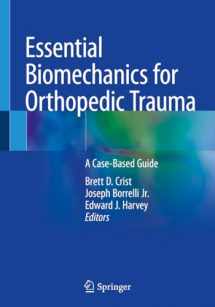
Essential Biomechanics for Orthopedic Trauma: A Case-Based Guide
Book details
Summary
Description
From the Back Cover
Biomechanics is often overlooked when dealing with orthopedic injuries, whether regarding prevention or treatment, and practicing surgeons and surgeons-in-training may feel overwhelmed when referring to a book with a more complicated basic science approach. In order to make the subject clinically relevant to orthopedic trauma surgery, this unique text presents numerous clinical case examples to demonstrate clearly and effectively the principles biomechanics of injury, fixation and fracture healing.
Divided into five sections, the opening chapters cover the essentials of stress and strain relevant to bone and joints and how this relates to fractures and their healing, complete with illustrative case material. This case-based approach is carried throughout the book, with part two discussing biomechanical principles of external fixation for diaphyseal and periarticular fractures, limb lengthening and deformity correction. Tension band wiring for both olecranon and patella fractures are covered in part three, and both locking and nonlocking plates are illustrated in part four. The final section describes biomechanical principles of intramedullary nails for a variety of fractures and nonunions, as well as arthrodesis and lengthening. Generous radiological images and intraoperative photos provide a helpful visual enhancement for the clinical material.
Making the sometimes esoteric topic of biomechanics more clinically relevant to the practicing clinician, Essential Biomechanics for Orthopedic Trauma will be an excellent resource not only for orthopedic surgeons, sports medicine specialists and trauma surgeons, but also medical and biomedical engineering students and residents.
Biomechanics is often overlooked when dealing with orthopedic injuries, whether regarding prevention or treatment, and practicing surgeons and surgeons-in-training may feel overwhelmed when referring to a book with a more complicated basic science approach. In order to make the subject clinically relevant to orthopedic trauma surgery, this unique text presents numerous clinical case examples to demonstrate clearly and effectively the principles biomechanics of injury, fixation and fracture healing.
Divided into five sections, the opening chapters cover the essentials of stress and strain relevant to bone and joints and how this relates to fractures and their healing, complete with illustrative case material. This case-based approach is carried throughout the book, with part two discussing biomechanical principles of external fixation for diaphyseal and periarticular fractures, limb lengthening and deformity correction. Tension band wiring for both olecranon and patella fractures are covered in part three, and both locking and nonlocking plates are illustrated in part four. The final section describes biomechanical principles of intramedullary nails for a variety of fractures and nonunions, as well as arthrodesis and lengthening. Generous radiological images and intraoperative photos provide a helpful visual enhancement for the clinical material.
Making the sometimes esoteric topic of biomechanics more clinically relevant to the practicing clinician, Essential Biomechanics for Orthopedic Trauma will be an excellent resource not only for orthopedic surgeons, sports medicine specialists and trauma surgeons, but also medical and biomedical engineering students and residents.


We would LOVE it if you could help us and other readers by reviewing the book
Book review



